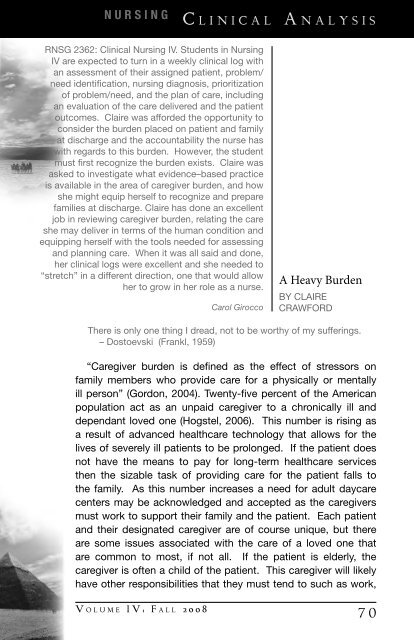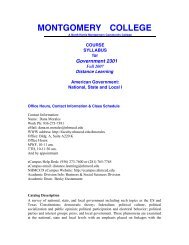2008 - Communication Across the Curriculum (CAC)
2008 - Communication Across the Curriculum (CAC)
2008 - Communication Across the Curriculum (CAC)
You also want an ePaper? Increase the reach of your titles
YUMPU automatically turns print PDFs into web optimized ePapers that Google loves.
N u r s i n g<br />
C l i n i c a l A n a l y s i s<br />
RNSG 2362: Clinical Nursing IV. Students in Nursing<br />
IV are expected to turn in a weekly clinical log with<br />
an assessment of <strong>the</strong>ir assigned patient, problem/<br />
need identification, nursing diagnosis, prioritization<br />
of problem/need, and <strong>the</strong> plan of care, including<br />
an evaluation of <strong>the</strong> care delivered and <strong>the</strong> patient<br />
outcomes. Claire was afforded <strong>the</strong> opportunity to<br />
consider <strong>the</strong> burden placed on patient and family<br />
at discharge and <strong>the</strong> accountability <strong>the</strong> nurse has<br />
with regards to this burden. However, <strong>the</strong> student<br />
must first recognize <strong>the</strong> burden exists. Claire was<br />
asked to investigate what evidence–based practice<br />
is available in <strong>the</strong> area of caregiver burden, and how<br />
she might equip herself to recognize and prepare<br />
families at discharge. Claire has done an excellent<br />
job in reviewing caregiver burden, relating <strong>the</strong> care<br />
she may deliver in terms of <strong>the</strong> human condition and<br />
equipping herself with <strong>the</strong> tools needed for assessing<br />
and planning care. When it was all said and done,<br />
her clinical logs were excellent and she needed to<br />
“stretch” in a different direction, one that would allow<br />
her to grow in her role as a nurse.<br />
Carol Girocco<br />
A Heavy Burden<br />
by Claire<br />
Crawford<br />
There is only one thing I dread, not to be worthy of my sufferings.<br />
– Dostoevski (Frankl, 1959)<br />
“Caregiver burden is defined as <strong>the</strong> effect of stressors on<br />
family members who provide care for a physically or mentally<br />
ill person” (Gordon, 2004). Twenty-five percent of <strong>the</strong> American<br />
population act as an unpaid caregiver to a chronically ill and<br />
dependant loved one (Hogstel, 2006). This number is rising as<br />
a result of advanced healthcare technology that allows for <strong>the</strong><br />
lives of severely ill patients to be prolonged. If <strong>the</strong> patient does<br />
not have <strong>the</strong> means to pay for long-term healthcare services<br />
<strong>the</strong>n <strong>the</strong> sizable task of providing care for <strong>the</strong> patient falls to<br />
<strong>the</strong> family. As this number increases a need for adult daycare<br />
centers may be acknowledged and accepted as <strong>the</strong> caregivers<br />
must work to support <strong>the</strong>ir family and <strong>the</strong> patient. Each patient<br />
and <strong>the</strong>ir designated caregiver are of course unique, but <strong>the</strong>re<br />
are some issues associated with <strong>the</strong> care of a loved one that<br />
are common to most, if not all. If <strong>the</strong> patient is elderly, <strong>the</strong><br />
caregiver is often a child of <strong>the</strong> patient. This caregiver will likely<br />
have o<strong>the</strong>r responsibilities that <strong>the</strong>y must tend to such as work,<br />
V o l u m e I V : F a l l 2 0 0 8<br />
7 0






